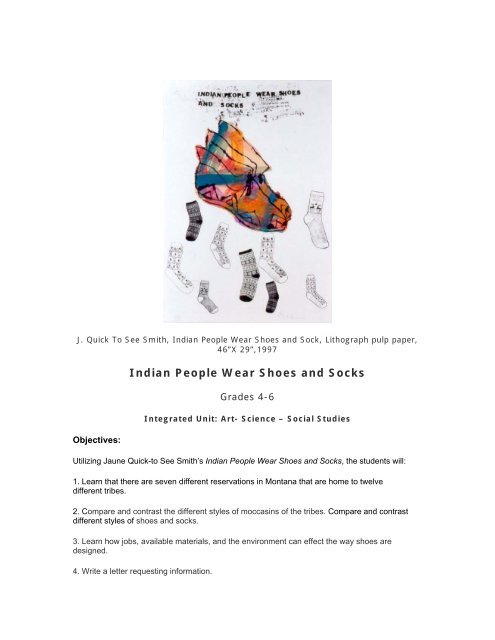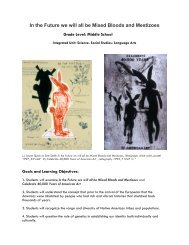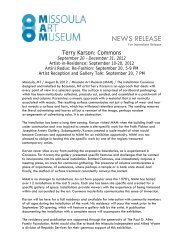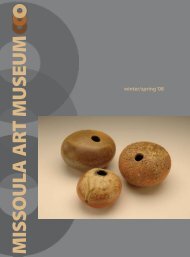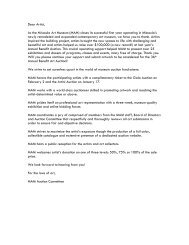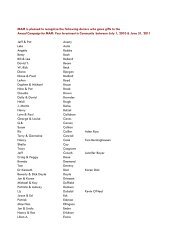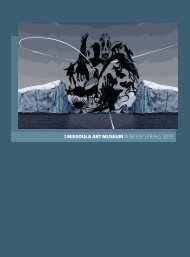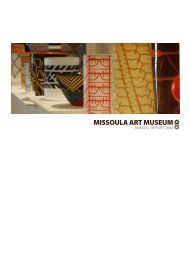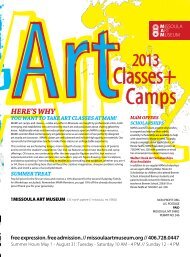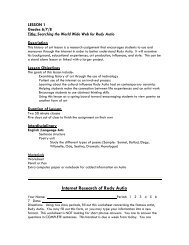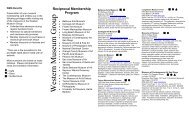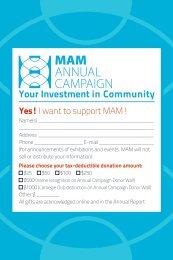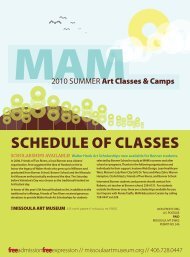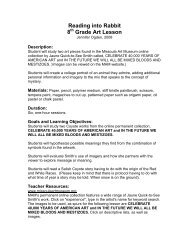Indian People Wear Shoes and Socks - Missoula Art Museum
Indian People Wear Shoes and Socks - Missoula Art Museum
Indian People Wear Shoes and Socks - Missoula Art Museum
Create successful ePaper yourself
Turn your PDF publications into a flip-book with our unique Google optimized e-Paper software.
J. Quick To See Smith, <strong>Indian</strong> <strong>People</strong> <strong>Wear</strong> <strong>Shoes</strong> <strong>and</strong> Sock, Lithograph pulp paper,<br />
46”X 29”,1997<br />
Objectives:<br />
<strong>Indian</strong> <strong>People</strong> <strong>Wear</strong> <strong>Shoes</strong> <strong>and</strong> <strong>Socks</strong><br />
Grades 4-6<br />
Integrated Unit: <strong>Art</strong>- Science – Social Studies<br />
Utilizing Jaune Quick-to See Smith’s <strong>Indian</strong> <strong>People</strong> <strong>Wear</strong> <strong>Shoes</strong> <strong>and</strong> <strong>Socks</strong>, the students will:<br />
1. Learn that there are seven different reservations in Montana that are home to twelve<br />
different tribes.<br />
2. Compare <strong>and</strong> contrast the different styles of moccasins of the tribes. Compare <strong>and</strong> contrast<br />
different styles of shoes <strong>and</strong> socks.<br />
3. Learn how jobs, available materials, <strong>and</strong> the environment can effect the way shoes are<br />
designed.<br />
4. Write a letter requesting information.
5.Use the Internet <strong>and</strong> select appropriate web sites to find information.<br />
Vocabulary:<br />
Tribe – a group of people sharing a common ancestry, language, culture, <strong>and</strong> name<br />
Moccasin – a soft leather slipper worn by Native Americans<br />
Symbol – an object or design used to represent an idea or another object.<br />
Decoration – an object or group of objects used to decorate; ornament; or embellish<br />
Activity 1: View <strong>Indian</strong> <strong>People</strong> <strong>Wear</strong> <strong>Shoes</strong> <strong>and</strong> <strong>Socks</strong> <strong>and</strong> discuss the<br />
following questions.<br />
Students may work in large group or small group setting. They should record their responses to<br />
the questions, which can then be used in writing activity 3. If students are not familiar with<br />
working in small cooperative groups, then model brainstorming <strong>and</strong> recording the answers by<br />
doing the first two questions as a large group. By utilizing small groups, all students will have an<br />
opportunity to voice their ideas. Remember that when brainstorming all responses are<br />
acceptable.<br />
Why is the moccasin in color<br />
Why are the European style socks in black <strong>and</strong> white<br />
What types of designs are on the moccasins<br />
What types of designs are on the socks<br />
Why do you think that Ms Quick-to-See Smith chose those particular designs <strong>and</strong> colors for the<br />
socks Do the designs on the socks reflect Ms. Quick-To-See Smith’s Salish heritage (Tell the<br />
students that the Salish are noted for their beadwork, which utilizes abstract plant <strong>and</strong> geometric<br />
designs.) How many styles of socks are there What other styles of socks could Jaune Quick-to-<br />
See use What other types of designs does one find on socks that are available for purchase<br />
What does the title <strong>Indian</strong> <strong>People</strong> <strong>Wear</strong> <strong>Shoes</strong> <strong>and</strong> <strong>Socks</strong> mean to you<br />
Why do you think that Jaune Quick-to-See used a newsprint style writing When you answer this<br />
question think about what newspapers communicate to the reader.<br />
Activity 2 Research (Individual or Paired)<br />
Tribal Cultural Committees should be contacted when researching the customs of different tribes.<br />
I have found the representatives of the different cultural committees to be extremely helpful.<br />
1. Find out how many Native American Reservations exist in Montana <strong>and</strong> what tribes<br />
reside on those reservations
2. Contact the Tribal Councils for information on specific styles of moccasins for each tribe.<br />
Students should write the letters for the information. (Tribal council contact information<br />
can be found at www.mtwytlc.com.) Student’s letters should include the following<br />
questions: How is the moccasin designed How the moccasin is made What materials<br />
are used in making the moccasin What are types of decorations are on the moccasins.<br />
Have the materials or designs in the decorations changed from generation to generation<br />
3. An excellent background information site is www.native-languages.org/moccasins.htm.<br />
The site shows pictures of the different styles <strong>and</strong> bead work for some of the Montana<br />
tribes <strong>and</strong> could be used in lieu of the letter writing activity.<br />
Activity 3 Small Group Activity<br />
Students will use the responses from their letters to create a chart that shows the moccasin<br />
design <strong>and</strong> the types of decorations that are on the moccasins.<br />
List the materials that are used in making the moccasin.<br />
Have the students compare their charts to answer the following question.<br />
How do moccasin styles differ from tribe to tribe<br />
Resource: http://www.teachervision.fen.com/graphic-organizers/printable/6287.html<br />
Activity 4: Writing<br />
Create a newspaper with articles about different styles of footwear <strong>and</strong> socks that you wear.<br />
Newspapers could also include articles about the moccasins. Tell how your footwear <strong>and</strong> socks<br />
demonstrate the kind of work or play that that you do. (Students should research the answers to<br />
these questions.) Include the answers to following questions:<br />
1. Where do your different types of footwear come from<br />
2. What are your shoes made of<br />
3. How are your shoes made<br />
4. Where are the socks made<br />
5. How are socks made<br />
6. Are there different types of socks for different activities<br />
Students should work in small groups to create their newspapers. I generally have the students put their articles on large<br />
sheets of white butcher paper so they can be displayed in the hall or library. Students create their own mastheads <strong>and</strong><br />
use the local newspaper as a model. Newspapers can also be created in the computer lab; however, I find that my<br />
students typing skills are limited <strong>and</strong> the time used in typing their articles <strong>and</strong> creating their papers could be better used<br />
studying other things.<br />
Activity 5: <strong>Art</strong><br />
This activity could be teamed with your art teacher.<br />
Materials: socks <strong>and</strong> shoes or outline images of socks <strong>and</strong> shoes, glue, water based tempera<br />
paint, plastic to protect desks <strong>and</strong> floor if using paint, colored markers, found materials; such as,<br />
buttons, feathers, sequins, glitter, plant materials, pictures, etc.<br />
Have students bring materials from home to decorate their socks or shoes. Create socks or<br />
shoes that reflect who they are as individuals <strong>and</strong> the things that are important to them.
Assessment<br />
Students have included their final products info that they have learned from their research <strong>and</strong><br />
from their letters.<br />
Related Readings:<br />
Nichelason, Margery G. <strong>Shoes</strong>. Minneapolis, MN: Carolrhoda Books, Inc., 1997.<br />
Smith, Cynthia Leitich. <strong>Indian</strong> <strong>Shoes</strong>. New York: HarperCollins, 2002.<br />
Unlike contemporary stories of <strong>Indian</strong> families written by non-Native authors, <strong>Indian</strong> <strong>Shoes</strong><br />
is mixed-blood-walking-in-two-worlds-dilemma free. No dream catchers, no <strong>Indian</strong> rituals, either.<br />
Instead, here are six stories about a Cherokee-Seminole youngster named Ray, secure in the<br />
loving care of his Grampa Halfmoon <strong>and</strong> his extended family in Chicago <strong>and</strong> rural Oklahoma.<br />
From trading his own high-tops so that Grampa can have a pair of moccasins, to overcoming a<br />
really serious wardrobe dilemma, to finding a creative solution to a dreadful haircut, to caring for<br />
their neighbors’ many pets on Christmas Day, to midnight fishing <strong>and</strong> finding out that contests are<br />
not always about winning, these stories are goofy, quirky, laugh-out-loud funny, <strong>and</strong> poignant,<br />
sometimes all together. <strong>Indian</strong> <strong>Shoes</strong> is about belonging to family <strong>and</strong> community, about helping<br />
neighbors, about learning life’s lessons, <strong>and</strong> about sometimes feeling different but most times<br />
knowing who you are in the world. – Beverly Slapin (Oyate)<br />
Resources:<br />
Biography of Jaune Quick-to-See is found on the MAM website<br />
Tribal council contact information can be found at www.mtwytlc.com.<br />
Every school library should also have <strong>Indian</strong> Education for All: Connecting Cultures <strong>and</strong><br />
Classrooms. If your district’s copies are not there, see your administrators or contact OPI.<br />
Tribal Councils <strong>and</strong> cultural committee addresses may also be found on the <strong>Indian</strong> Education for<br />
All website at OPI. The OPI website is www.opi.mt.gov<br />
The Smithsonian National <strong>Museum</strong> of the American <strong>Indian</strong> www.nmai.si.edu is another excellent<br />
site.<br />
The following Essential Underst<strong>and</strong>ings are incorporated or reflected in the following<br />
activity.<br />
Essential Underst<strong>and</strong>ing 2<br />
There is great diversity among individual American <strong>Indian</strong>s as identity is developed, defined, <strong>and</strong><br />
redefined by entities, organizations, <strong>and</strong> people. A continuum of <strong>Indian</strong> identity, unique to each<br />
individual, ranges from assimilated to traditional. There is no generic American <strong>Indian</strong>.<br />
Essential Underst<strong>and</strong>ing 3<br />
The ideologies of Native traditional beliefs <strong>and</strong> spirituality persist into modern-day life as tribal
cultures, traditions, <strong>and</strong> languages are still practiced by many American <strong>Indian</strong> people <strong>and</strong> are<br />
incorporated into how tribes govern <strong>and</strong> manage their affairs. Additionally, each tribe has its own<br />
oral histories, which are as valid as written histories. These histories predate the "discovery" of<br />
North America.<br />
Essential Underst<strong>and</strong>ing 6<br />
History is a story most often related through the subjective experience of the teller. With the<br />
inclusion of more <strong>and</strong> varied voices, histories are being rediscovered <strong>and</strong> revised. History told<br />
from an <strong>Indian</strong> perspective frequently conflicts with the stories mainstream historians tell.<br />
Montana St<strong>and</strong>ards for Social Studies that are reflected in the activities.<br />
Content St<strong>and</strong>ard 1—Students access, synthesize, <strong>and</strong> evaluate information to communicate<br />
<strong>and</strong> apply social studies knowledge to real world situations.<br />
Content St<strong>and</strong>ard 4—Students demonstrate an underst<strong>and</strong>ing of the effects of time, continuity,<br />
<strong>and</strong> change on historical <strong>and</strong> future perspectives <strong>and</strong> relationships.<br />
Content St<strong>and</strong>ard 6—Students demonstrate an underst<strong>and</strong>ing of the impact of human<br />
interaction <strong>and</strong> cultural diversity on societies.


